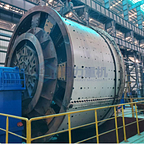What is a vertical roller mill(VRM)? Unlocking the Power of Vertical Roller Mills: Your Ultimate Guide to Choosing the Perfect VRM and supplier/manufacturer.
Introduction to the Vertical Roller Mill
Efficiency and precision are perpetual pursuits in the realm of industrial manufacturing and processing. A critical tool in the pursuit of these objectives is the Vertical Roller Mill (VRM). This intricate machinery has revolutionized several industries, including cement, mining, and more. This comprehensive guide delves into the world of VRMs, offering insights into what they are, how they operate, and invaluable guidance on selecting the ideal vertical roller mill for your specific needs.
History development of vertical roller mill
The inception of VRMs dates back to the early 20th century when the first VRM was patented in the United States. However, it was not until the 1990s that this technology gained widespread acceptance and became an integral part of modern industrial grinding processes.
Grasping the Fundamentals: The working mechanism
At its core, a Vertical Roller Mill is a specialized apparatus designed for fine and ultra-fine grinding. It excels in applications demanding high energy efficiency and precise control over particle size distribution. Unlike conventional ball mills or hammer mills, VRMs employ a blend of compression and shear forces to reduce materials into smaller particles. The main components of the cement vertical roller mill include the grinding table, grinding rollers, grinding roller shaft, grinding roller wheel hub, grinding roller tyre, rocker arms, separator, transmission system, middle shell, base frame.
Grinding Table: The grinding table is a rotating part of the cement vertical roller mill responsible for grinding materials. It is mounted on a gearbox-driven spindle and can be tilted to control the product fineness and optimize the grinding process. The detailed structure of the grinding table includes guide ring, air ring, retaining ring, liner, disc body, scraper.
Grinding Rollers: Grinding roller is the main part for crushing and grinding materials. The grinding roller is composed of cast steel roller sleeve, forging shaft and wear-resistant surfacing bushing. The grinding roller is installed on the rocker arm of the cement vertical roller mill, under the action of external force, it is pressed tightly on the material of the grinding table, as the grinding table rotates the material is crushed. The grinding roller is equipped with a limit device to ensure that it does not directly contact the grinding table during operation.
Rocker Arms: The function of the rocker arm device of the cement vertical roller mill is to transmit the pressure provided by the hydraulic cylinder to the grinding roller, so that it can be transformed into the grinding force act on the material bed. The rocker arm device is mainly composed of upper rocker arm, lower rocker arm, rocker arm shaft, bearing and bearing housing and other components. The upper rocker arm is used to install the grinding roller, the lower rocker arm is connected to the hydraulic system, and the two rocker arms are connected as a whole through shafts, taper sleeves and taper pins.
Base Frame: The support base of the vertical mill is generally four peripheral support pedestal and a central support base, and the support base and the installation foundation are connected and fixed by anchor bolts. All the cement vertical roller mills of Tongli will be pre-assembled and leveling calibrated before leaving the factory to ensure that the equipment can be installed smoothly on site.
How does a vertical Roller Mill Work?
VRMs operate on a unique principle that sets them apart from traditional ball mills or hammer mills. The material is crushed and ground by the pressure exerted between the grinding rollers and the grinding table. As the material passes through the rollers, it is simultaneously dried and classified by the separator. This dual-action process results in a high level of energy efficiency, making VRMs an eco-friendly option in industrial grinding applications.
How to select the right Vertical Roller Mill ?
Material Compatibility
Different materials require different grinding solutions. Cement, for instance, has distinct grinding characteristics compared to minerals or raw materials. Ensure that the VRM you choose is compatible with the material you intend to process.
Capacity and Throughput
VRMs come in various sizes and capacities. Consider your production requirements and select a mill that can handle the desired throughput. It’s essential to strike a balance between capacity and energy consumption to optimize operational costs.
Fineness Requirements
The level of fineness you require for your end product is a critical factor. VRMs offer excellent control over the fineness of the final product. Be sure to choose a mill that can achieve the desired particle size distribution.
Energy Efficiency
Sustainability and energy efficiency are becoming increasingly important in industrial processes. Look for VRMs that offer high energy efficiency to reduce operating costs and minimize environmental impact.
How to do maintenance and optimization of Vertical Roller Mills ?
Routine Maintenance
To ensure the longevity and efficiency of your VRM, a proactive maintenance schedule is essential. Regularly inspect and replace worn components, such as grinding rollers and table liners.
Process Optimization
Maximize the performance of your VRM by continually monitoring and optimizing the grinding process. Adjust parameters like grinding pressure, airflow, and separator speed to achieve the desired product quality and throughput.
What is a vertical roller mill conclusion:
The vertical roller mill, with its exceptional efficiency and versatility, has revolutionized industrial grinding processes across various sectors. Understanding its components and operating principles is crucial in harnessing its full potential.
When selecting a vertical roller mill, it’s imperative to define your objectives, consider material compatibility, assess capacity and throughput requirements, prioritize fineness, and evaluate energy efficiency, maintenance, and cost considerations. Consulting with experts can also provide valuable guidance.
Mastering the grind with the right VRM can enhance your production efficiency, reduce operational costs, and contribute to a sustainable future in industrial manufacturing.
Investing time and effort in selecting the perfect VRM today will pave the way for a more prosperous and efficient tomorrow.
Reference:
Date: 2023–10–03 1:26
Author: Richard.Z
